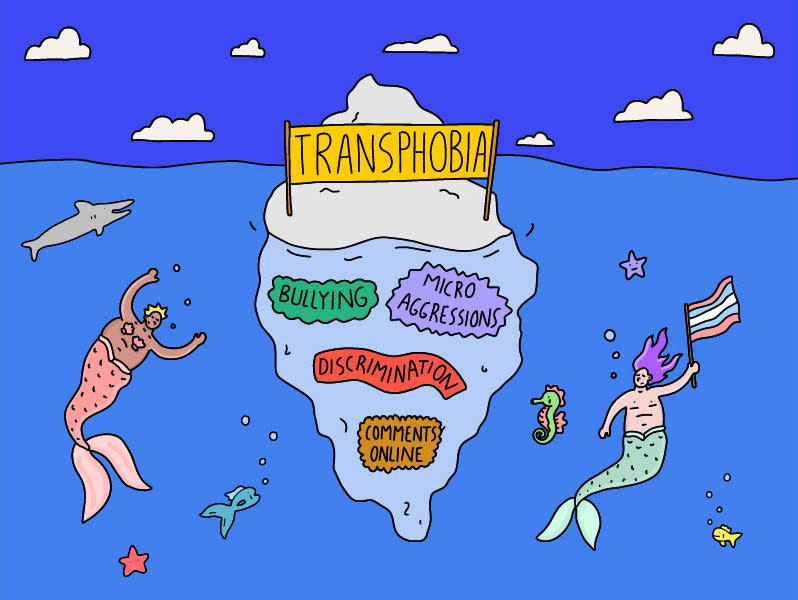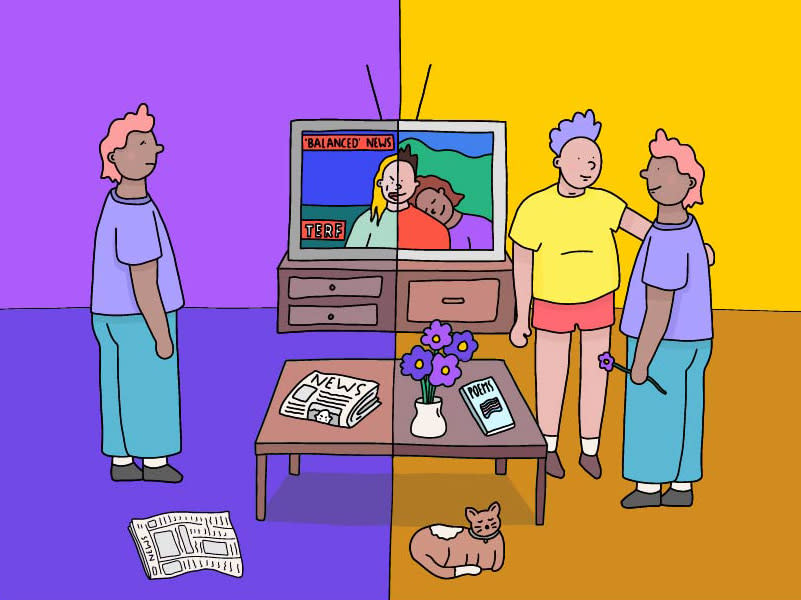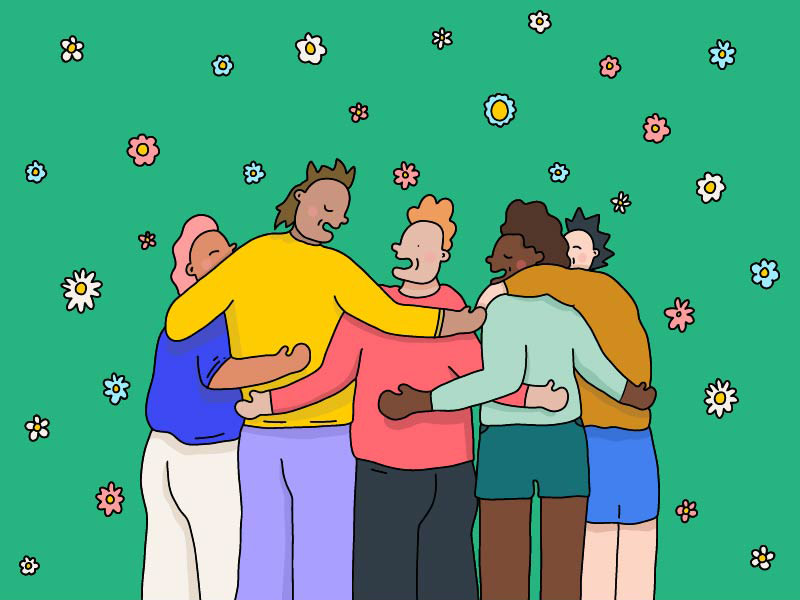How to cope with transphobia
Knowing how to cope with transphobia is an important skill for members of the trans community, since trans, gender diverse and non-binary (TGDNB) young people report much higher rates of verbal and physical harassment than cisgender people.
Experiencing transphobia can be really scary and emotionally exhausting, so we’ve put together this guide to help you feel better, and to learn how to support yourself and connect with your community.
In this article, we'll cover:
What is transphobia?
Transphobia is any negative feeling, behaviour or language directed at TGDNB people because of their gender identity.
Repeated transphobia is a form of bullying, and can be really harmful. Transphobia may also lead to discrimination, which is when someone is targeted and treated differently because of their identity or characteristics. Sometimes transphobia is passed off as ‘banter’, but this doesn’t make it okay, and it can still make you feel uncomfortable, angry or upset.
Transphobia doesn’t have to target you directly to have a negative impact on your wellbeing or sense of self. You may see transphobic comments online or witness transphobia in the media, or your friends and family might make negative judgements or comments about trans people.
Internalised transphobia
If you are a TGDNB person or are questioning your gender and you feel negatively about your identity, you may be experiencing internalised transphobia.This isn’t your fault. It’s often a result of being raised with the false and harmful belief that being cisgender is the only correct way to present, and that sitting outside of the gender binary is wrong or strange.
Internalised transphobia can also stem from poor media representation of trans people. When you hear and see a lot of negativity surrounding your identity, you may grow to fear or resent it and to think negatively about yourself. This can lead to negative self-talk, not feeling good or comfortable in your body and, potentially, to depression or anxiety.
Overcoming internalised transphobia is a journey that will likely include a lot of reflection on your life, upbringing and biases. It’s important to have a strong support system to help guide and care for you during this process. There are many places to find support, including:
ReachOut Online Community, where you can connect with gender diverse people who have been through similar experiences
professional mental health services like therapy, QLife and ReachOut PeerChat, where you can chat to a peer support worker who understands what you’re going through
queer magazines and websites where you can hear from others about their journey.
How to cope with transphobia
Prioritise your safety
When you are experiencing transphobia, you can feel at risk, especially if it is accompanied by violence or threatening actions. In the moment, it’s important to put your safety first and remove yourself from the situation if possible. This could look like leaving an area to seek a safe space and support person, or stepping away from your device and planning to report or delete the comments/post/messages.
Ask for support
You don’t have to go through transphobic situations alone. It’s okay to ask for support from your friends, family, teacher, support services or even from bystanders if you need to.
Talking with someone you trust, especially someone who can relate to you, gives you the space to vent or cry or be angry. You can talk about how you feel, or just ask them for support in other ways, a warm hug or doing something nice together.
If you don’t feel comfortable going to someone you know or you'd just prefer privacy, try accessing online or phone support. There are many different online and phone support options, including:
ReachOut Online Community, where you can meet new people and talk through your experiences
QLife web chat, where you can speak to a peer worker who is a member of the LGBTQIA+ community
ReachOut Peer Chat, where you can speak one-on-one with peer workers
eHeadspace, where you can speak to a counsellor online or on the phone
Kids Helpline, who you can call anytime for support on 1800 55 1800.
You can find a whole heap of different support groups specifically for trans people over at Transcend.
Access professional help
Speaking with a professional like a psychologist or a peer worker can help you work through your emotions in a safe space and share how the experience has impacted your mental health and wellbeing. Together, you can create a wellbeing plan and explore new ways to look after yourself.
It might feel nerve-racking to seek professional support as a TGDNB person. You may be worried about having a negative experience or having your identity and experiences invalidated. Look into your rights as a TGDNB patient and learn more about choosing the right mental health professional for you.
The digital services above are good options for chatting with peer workers or online counsellors. You can also search online for practitioners who are supportive of trans health, or check out our resources on accessing professional help to learn more about where to start and what to expect.
Look after your wellbeing
If you’re feeling good, it will be easier to cope when you go through something that really hurts. Wellbeing is really all about you doing the fun things you love, in order to feel good. By practising self-care, checking in with yourself and seeking support whenever you need it, you are building your resilience so that you can bounce back faster from tough situations.
There are plenty of ways to practise self-care, including:
gaming
playing sports or exercising
journalling or meditating
doing a beauty routine
doing something gender affirming like dressing in your favourite outfit
listening to music or watching an episode of your favourite TV show
discovering more about your community or identity through books, videos and content creators
celebrating trans joy!
Celebrating your own wins and sharing in the joy of other people in your community is another special and important part of combatting transphobia and caring for your emotional wellbeing.
Reject transphobic media
Over the past decade, transgender identities and issues have become much more talked about in the media and in politics. Constantly seeing your identity discussed and politicised can be incredibly emotionally draining.
If you’re feeling exhausted by all the media attention, you aren’t alone. Over 90 per cent of gender diverse young people in Australia have reported that they experience high or very high levels of psychological distress.
It’s okay to take a break from engaging with the media or the politics around your identity. Although it may be hard to step away, your wellbeing and safety should come first! Negative language and judgements of TGDNB people in the media can contribute to dysphoria and strained mental health, so you might want to consider disconnecting regularly from the discussion.
Here are some things you can do to help your disconnect:
Do a social media cleanse and unfollow people and publications who are spreading transphobia or harmful posts.
Start your day with something calming like a meditation, rather than jumping straight online or on your phone.
Let your friends know, so that they don’t bring it up with you.
Watch some wholesome content or switch from streaming to self-care.
Report and block people who are making transphobic content and comments.
Responding to transphobia
Responding directly to transphobia can feel really good, like you’ve achieved something positive. It can connect you with your community and can sometimes educate people who weren’t aware of how their actions were impacting others. But it can also be really tough, and in some instances it may be dangerous. Following a long reporting process can leave you feeling exhausted, especially if you don’t get the result you were hoping for.
This is why responding directly to transphobia is a choice. No matter what anyone says or is pressuring you to do, it’s your decision to respond in a way that keeps you safe and puts your wellbeing first.
If you choose to respond directly, you have a lot of options. You can:
respond in the moment by standing up for yourself or others and trying to educate the person/s responsible for the behaviour
tell your parents, friends or another trusted person and allow them to respond on your behalf
report the behaviour to your school, TAFE or uni and follow their reporting processes
speak about the incident online on your social accounts or in queer spaces
report the online incident to eSafety or ReportCyber
report the incident to the police. (Learn more about interacting with the police as a TGDNB person here.)
Let your loved ones or someone you trust know your plan so that they can support you. After you respond, do something nice for yourself that will make you feel good.
When you experience frequent transphobia, it can be easy to forget how incredible it is to live as a TGDNB person. Living as yourself may make others fearful or angry, but that doesn’t mean it’s not beautiful, exciting or wonderful to be you. A huge part of looking after your wellbeing as a TGDNB person is finding and celebrating the gender diverse and trans joy in your life. Remind yourself that although it may be hard right now, your life as a TGDNB person can be equally joyful, exciting and beautiful!
What can I do now?
Check out this list of LGBTQIA+ support services from across the country.
Celebrate your story of gender diverse and trans joy on the Online Community.



